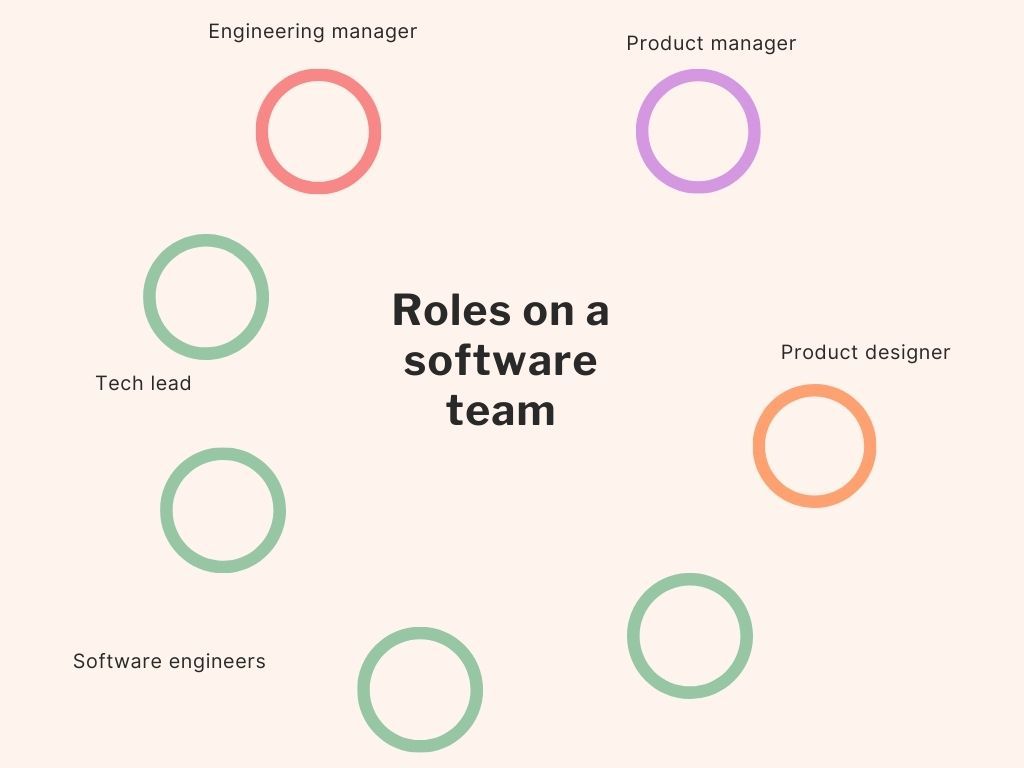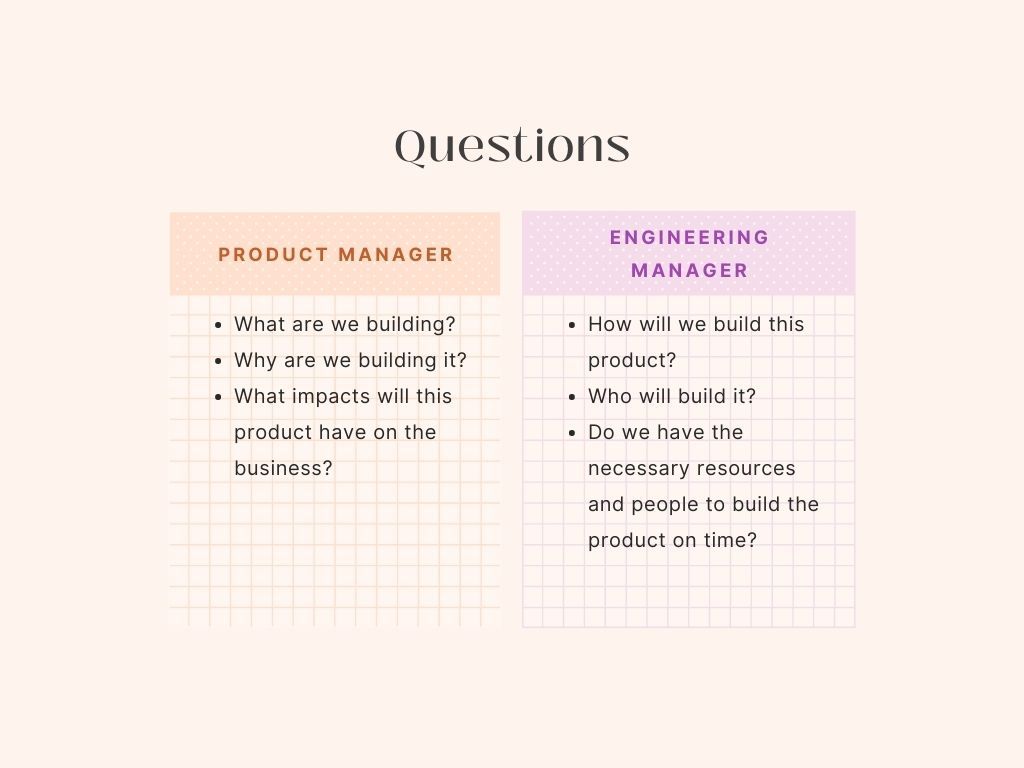Engineering Manager vs. Product Manager: What's the Difference?

Product managers and engineering managers are common roles on software teams. Even though the titles may seem similar at first glance, the two jobs are quite different, and the way a product manager and engineering manager interact has many implications for the success and health of the team.
In this article, we cover
- What the product manager and engineering manager roles are
- Why having a strong working relationship between them is so important
- When areas of tension and conflict might arise
- How engineering managers and product managers can collaborate well and build strong rapport
Want to learn more about what product managers and engineering managers do? Book some time with our product management and engineering management mentors on Merit by signing up today.
The Engineering Manager and Product Manager on a Team
An “average” software team typically has an engineering manager, a product manager, a designer, and several software engineers, one of whom may be a tech lead.

Product manager and engineering manager. Both titles have the word “manager” in them, so aren’t they both managers? Not quite. The product manager is an individual contributor—no one reports to them. Meanwhile, the engineering manager is a people manager: among other tasks, they are responsible for the growth and career development of the software engineers on their team(s).
The product manager vs. engineering manager dynamic comes down to who owns which aspects of developing a product. At the highest level, the product manager is responsible for the “what” and “why”: “What is the product we’re building, and why are we building it?”
The engineering manager is responsible for “how” and “who”: “How will we build this product, and who will build it?”
As Sha-Mayn Teh, startup advisor and former Engineering Manager at Google, describes it, the product manager focuses on, “What problem are we trying to solve? Who are the users, the use cases, the requirements, the why of this product? As the engineering manager, I would figure out how to do it, how to build it, how to structure the teams so we can build it, how to make sure that team executes.”
The two will most likely collaborate on and negotiate the “when”: “Given the staffing, resources, and requirements, when can we expect to launch this product? If we have an external deadline, what will need to change to meet it?”

The Importance of the Product Manager and Engineering Manager Relationship
The engineering manager and product manager relationship is the backbone of successful product development. The success and health of a team is often directly correlated to the strength of that dynamic. KC Oh, Product Manager at Figma, says, “They’re responsible for helping to facilitate an environment where people can be successful.”
Although the product manager isn’t a people manager, together with the engineering manager, the two are the de facto team leadership. Together, an engineering manager and product manager
- Set the tone for the team: Whenever a new project is introduced, a deadline is changed, or company news is shared, the way the product manager and engineering manager communicate this messaging signals how the team should interpret the information.
- Represent the team to their respective departments and to leadership: The product manager represents the team to their larger product management organization, while the engineering manager acts as the liaison between the team and the rest of the engineering department. They both together act on behalf of the team with leadership and the executive team.
- Maintain alignment on the product and technical roadmaps: The engineering manager and product manager must maintain a united front on the priority of of what will be delivered when.
Sources of Conflict
Engineering managers and product managers, despite being two key roles on a team, may encounter conflicts. Most conflicts arise from one of two sources: overlapping responsibilities and differing goals.
Product managers and engineering managers may have misaligned expectations on who does what.
- Administration: A small example is the running of sprint rituals and ceremonies; the engineering manager might think they’re responsible for leading the sprint planning meeting, while the product manager may think they’re the rightful owner.
- Timelines: Both may think they are responsible for defining “when” a product will be delivered, when in reality it’s a negotiation between scope (usually defined by the product manager and designer) and resources available (usually determined by the engineering manager).
- Project management: Not all teams have a dedicated project manager. As a result, keeping track of the work in flight, dependencies, and if work is on or off track may fall through the cracks, unless an EM and PM decide who will take on project management responsibilities.
- In other cases, product managers may think that engineering managers are responsible for the project management responsibilities of delivering a product; engineering managers might think the opposite.
Product managers and engineering managers also have differing goals:
- Time versus quality: The product manager is under pressure to deliver a product, quickly; the engineering manager is under pressure to keep their reports’ morale high and deliver a bug-free, low-debt product. Kirk Fernandes, co-founder at Merit and former product manager, expands on this idea: “The product manager and engineering manager have different ‘products’: the engineering manager’s product is the engineering team and codebase itself. How easy is it to ship and update code? How easy is it to change the composition of the team? The product manager’s product is whatever customer problem needs to be solved for the company’s business model to work.”
- Success metrics and KPIs: The product manager is responsible for driving user engagement and usage metrics; the engineering manager is looking to increase code quality, team velocity, and team happiness.
- Prioritization of technical debt: Technical debt slows down engineers and reduces the quality of new code. As a result, engineering managers will want to devote resources and time to “paying down the debt.” Product managers may view this time spent on technical debt as detracting from delivering products. The two may have to frequently revisit how much time is being allocated to addressing debt.
Building a Strong Relationship
With all of these potential conflicts, engineering managers and product managers must actively work together to address any problems and build a strong working relationship.
To nurture collaboration, consider
- Holding regular one-on-ones: Set aside thirty minutes every week to catch up. This time does not entirely have to be about work, although it helps to maintain a running agenda. Use this time as an opportunity to see how the other person is doing, build rapport, and discuss any major issues the team might be facing.
- Share best practices and set the stage: Neil Gangal, Product Manager at League, suggests, “Something that is helpful to do at the beginning of the relationship is sharing best practices. Ask, ‘Hey, what has worked really well in the past when you worked with EMs or PMs; what are some things that haven’t worked?’” By asking the other person upfront what they’ve seen work well or not work well can tell you about their preferred working style.
- Shouldering the burden: Both roles have lots of responsibilities—so sometimes taking something off the other person’s plate can be a huge help. If a product manager is underwater and has an executive presentation to prep, the engineering manager can offer to help make it. If it’s performance review season, and the engineering manager is swamped, the product manager can offer to take on some of the engineering manager’s tasks.
- Having the other’s back: Sometimes things can go wrong on a team. Someone made a mistake; the project went way over time or budget; the delivered product isn’t anything like what was promised. In these cases, both the product manager and engineering manager should support the other’s decisions and take accountability for their own actions.
- Informal daily check ins: Although engineering managers and product managers are probably talking to each other daily during stand-up, it doesn’t hurt to send a quick message over Slack, saying, “Hey, how’s it going?” or sharing a quick update that the other person may not have heard.
When conflict arises, product managers and engineering managers can
- Provide feedback, quickly: Don’t let feedback sit and wait. In the first opportunity you have, share you feedback. (If the idea of giving feedback makes your heart race, check out these steps and tips.)
- Conduct a roles and responsibilities exercise: List out all the responsibilities across all the roles on the team. It can be from the macro, “creating and prioritizing the roadmap” to the micro, “maintaining the bug backlog.” Determine if the person primarily responsible is the engineering manager, product manager, or someone else. Conversely, you can define all the roles in the team and then fill out the responsibilities for each as described in Hackernoon.
- Fill out a DACI or RACI matrix: Similar to the roles and responsibilities exercise, write out your team’s typical process for building a given product or feature—everything from “interviewing users” to “developing prototypes” to “writing code” and “reviewing pull requests.” For each line item, determine who’s directly responsible, who’s accountable, who’s consulted, and who’s informed of the decision. Oh adds, “You need to get the other person to agree and acknowledge, ‘I will be the person doing that.’ You don’t have that murkiness on who’s going to do something. Over time, this becomes more explicit.”
- Bring up issues in sprint retrospectives: If a piece of feedback might best be discussed in front of the whole team, discuss it in retro. Retros should be blameless and in the spirit of improvement rather than complaining, but if the whole team needs to weigh in on what’s happening, retros are a good place to do it.
Still not sure about engineering managers and product managers and want to talk to them about their work? Sign up for Merit to speak with a product management or engineering mentor today.
Thank you to Sha-Mayn Teh, KC Oh, Neil Gangal, Sean Shannon, and Jennie Tang for sharing their insights, experience, and advice.
